BLOG
Narla Reunited with Family After Nine Months
We had a very heartwarming and unusual adoption in March, where Narla the Staffy (previously Jane) was reunited with her family after being lost for nine months!
In June last year, Narla was staying with a family friend and their dogs on the Central Coast while her owner Tammie and her husband were relocating to QLD. One day Narla and her canine friends got out and went missing. Her friends made it back home, but Narla couldn’t be found.
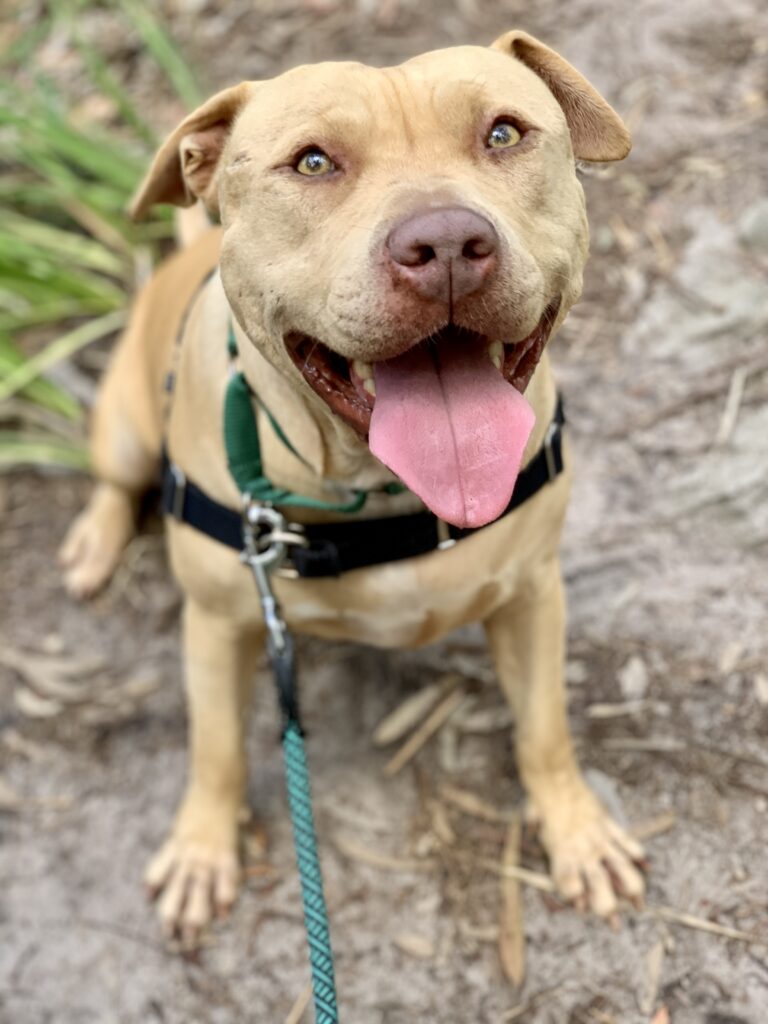 Nine months later, Tammie’s friend was looking to adopt a dog and noticed there was a Staffy with a striking resemblance to Narla on our website, with the same scar across her face. When Tammie saw the picture, she was certain it was her long-lost dog.
Nine months later, Tammie’s friend was looking to adopt a dog and noticed there was a Staffy with a striking resemblance to Narla on our website, with the same scar across her face. When Tammie saw the picture, she was certain it was her long-lost dog.
Tammie was eager to bring Narla home, so she booked a flight to fly her to QLD. When Narla touched down and was reunited with Tammie and her husband, it was clear she missed her family – her whole body started to wiggle!
Narla has since made herself at home in QLD and is back into the swing of things with her Chihuahua and English Staffy siblings. Tammie said, “it was like they’d never been apart.” She really enjoys her trips to the beach to run in the water and play with her canine companions. After lots of playtime at the Home, she’s also formed a new love of toy balls!
Milo & Roro: The Perfect Pair
When Milo was brought in by a council ranger at only 10-weeks-old, he was terrified. He would hide behind bowls and boxes when approached and would completely freeze when handled.
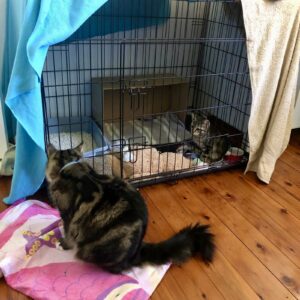 After health checks, Milo was sent straight into foster care with our Reception Team Leader Kylie to help minimise stress. Kylie quickly noticed he would come out of his shell when he heard her other cat vocalise. Milo would even talk back!
After health checks, Milo was sent straight into foster care with our Reception Team Leader Kylie to help minimise stress. Kylie quickly noticed he would come out of his shell when he heard her other cat vocalise. Milo would even talk back!
“He started purring when he saw my cat,” Kylie said.
“We persevered with my cat who didn’t really like him, but whenever he walked into the room, Milo came forward and was a different kitten. He would eat in front of me, give slow blinks and reach his paw out to touch my cat.”
Shortly after Milo went into foster care, a kitten named Roro arrived at the Home. Roro was playful and confident – a perfect influence for Milo. So Milo and Roro were introduced and sent into a foster home with Karin, one of our experienced carers.
Karin was a perfect fit, as she already has a laidback, confident cat named Mia, who she adopted from the Home a year prior.
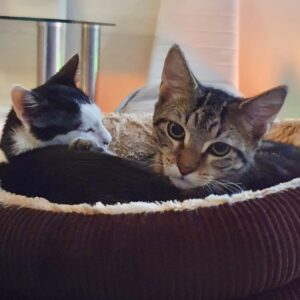 For the first two weeks, Milo seemed a bit confused about the concept of toys and playtime. But with Roro and Mia there to show him the ropes, he’s come to love batting around his jingle balls.
For the first two weeks, Milo seemed a bit confused about the concept of toys and playtime. But with Roro and Mia there to show him the ropes, he’s come to love batting around his jingle balls.
After over two months in foster care, Milo transformed from a scaredy-cat who was terrified of people to a young man who enjoys being picked up and held. Most of all, he loves playing with his foster sibling Roro.
Milo and Roro went up for adoption as a bonded pair and found the perfect home! They were adopted on 19 April by one of our long-term foster carers who is studying to be a vet. Milo and Roro are the family’s second and third cats from the Home, having adopted from us 11 years ago. Given their experience and knowledge of cat health and behaviour, they’re a fantastic match!
Chestnut the Staffy Saves Poisoned Puppy
 Chestnut the Staffy saved a Kelpie puppy’s life last week, after providing a blood donation to help cure the effects of rat bait poisoning.
Chestnut the Staffy saved a Kelpie puppy’s life last week, after providing a blood donation to help cure the effects of rat bait poisoning.
The 10-week-old puppy named Blu had been rushed to the vet hospital next door, where they discovered she had consumed rat bait poison before she was purchased, and was suffering breathing difficulties and internal bleeding that would normally be fatal.
Blu desperately needed a blood donation, so the vet hospital made an urgent call to Sydney Dogs & Cats Home, and our vet team sent over Chestnut the Staffy.
Sydney Dogs & Cats Home Animal Care Manager Renae said it was a carefully considered decision to send Chestnut to help save Blu.
“We of course made certain that Chestnut’s health and welfare would not be compromised by donating blood and we provided all the care and support she needed to recover,” she said.
This was an unusual situation for us but we’re glad that we could help save the life of a young pup. There is a real shortage of animal blood donors so we would encourage all pet owners to consider whether their pet could donate blood and be a hero too,” she said.
 Thanks to Chestnut’s blood donation, Blu has been in full health and is keeping her owner Corey on his toes with her newfound energy.
Thanks to Chestnut’s blood donation, Blu has been in full health and is keeping her owner Corey on his toes with her newfound energy.
Chestnut has also recovered well and has since been happily chewing away at the veggie pigs ears kindly donated by Blu’s owner Corey.
Corey has also enquired about adopting Chestnut, but she’s had to respectfully decline as she prefers to be spoilt as the only dog in the home.
After rescuing Blu, Chestnut herself is looking to be rescued! She’s Sydney Dogs & Cats Home’s longest-standing canine resident currently in care, having arrived as a lost dog in December.
Chestnut may be short in stature, but she’s big in personality and has lots of energy for walks and adventures.
To enquire about adopting the very brave Chestnut, visit her adoption profile: https://sydneydogsandcatshome.org/animal/chestnut/
UPDATE: Chestnut was adopted in early April!
The 12 Kittens of Christmas
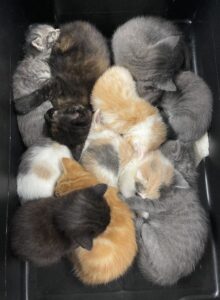 Everyone’s heard of the 12 Days of Christmas, but what about the 12 kittens of Christmas?
Everyone’s heard of the 12 Days of Christmas, but what about the 12 kittens of Christmas?
On 1 December 2020, a policeman arrived on our doorstep with a box of 12 tiny kittens. They had been found all alone at a local pool, underweight with an intestinal tract infection and flea infestation. Some kittens also had mild eye discharge and a sneeze. Being so small at around 4 weeks old, it was important we act fast to help the kittens, so our vet team prescribed anti-parasitic medication, eye drops and probiotics to put their tummies, eyes and skin at ease.
To ensure the kittens could be given the one-on-one attention they needed, they were sent into foster homes where they were medicated daily until their ailments were no more. Thanks to our wonderful donors, the kittens all received lots toys, blankets and beds, as well as high quality cat litter kindly provided by our sponsor Chandler Cat Litter.
Once settled, the kittens began to grow and gain weight. But for one little kitten named Noelle, her recovery wasn’t as straight forward. A few weeks after Noelle’s arrival, we received a call from her foster carer Robyn – Noelle was experiencing a hyperglycaemic attack and was lethargic and stopped eating. This is a very common condition in kittens where their blood sugar drops. Quick treatment is often the difference between life and death. Luckily, Robyn is an experienced and skilled foster carer who worked with our Foster Care Coordinator to save Noelle. Robyn administered sugar drops to the young kitten in regular intervals, and within 2.5 hours, Noelle’s sugar levels had stabilised. Robyn tells us, “it was a Christmas miracle.”
Noelle is now happy, healthy, and a little bit famous! Noelle, Oliver and Robyn appeared on Sunrise Weather with Sam Mac in December to represent the 12 kittens of Christmas, and they have since been very popular kitties.
The 12 kittens of Christmas are now available for adoption from foster care and our adoption partner PETstock. They’re looking for an indoor lifestyle and a family who can commit to giving them a home for life. Each kitten has their own unique personality:
- Mia is an independent and quiet girl who loves to play
- Andrew is a curious boy who loves his food
- Rusty is very playful and loves to explore
- Panda is confident, independent and likes to explore; she is great with cats, dogs and people
- Bear is a shy little guy who loves human attention and reassurance
- Daisy is an independent girl who loves to wrestle; when she’s had enough zoomies she likes to flop onto her humans and fall asleep
- Bonnie (bonded with Clyde) is a quiet girl who loves to have a good chat; she’s very keen on her food and has her affectionate moments
- Clyde (bonded with Bonnie) is a quiet, inquisitive guy who loves to hang out with his humans
- Noelle is confident, feisty and loves playing with feather and bell boys; she’s a lap cat and gives wonderful head bumps
- Oliver has boundless energy and loves his food; his signature move is “the meerkat nuzzle” where he stands on his back legs and nuzzles your hand
- Azrak (adopted) is playful and loves to bat around inanimate objects such as pens; he will sit on your shoulder
- Wobey likes to be picked up and follow his humans around; he loves to climb and play with his feather toys
To learn more about each of the 12 kittens of Christmas, see their adoption profiles: https://sydneydogsandcatshome.org/adopt/*
* If a kitten is listed as available from a PETstock store, please contact the store to enquire about adoption.
Microchip Reunites Long-lost Family Cat
Colleen was beside herself with joy when she found out her cat Leo had turned up at Sydney Dogs & Cats Home. It had been eight months since her family had seen him, so for Colleen “it didn’t seem real.”
In April, Colleen moved to a new house, transporting Leo in his cat carrier. When she let him out to explore the new place, he jumped into the garden and disappeared. Leo would normally come when he was called, so Colleen wandered around calling for him every time she went outside. About five days later Leo reappeared, hiding under the caravan, but when Colleen tried to retrieve him, he ran away.
Since their old house was just down the road, Colleen visited regularly for six weeks searching for Leo, but he was no where to be found.
Then, eight months down the track, we contacted Colleen’s family with some surprising news. Leo had just arrived with a council ranger, having been picked up around Colleen’s old house. Luckily he was microchipped, making it easy for us to find his family.
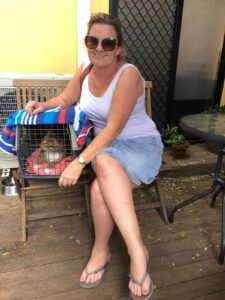 As soon as Colleen heard the news, she jumped onto our website to make sure it was real. “There were a few tears,” she said.
As soon as Colleen heard the news, she jumped onto our website to make sure it was real. “There were a few tears,” she said.
Since Leo has returned home, he’s been readjusting to family life, including having his feline sibling back. The first day he was very timid, but by nightfall, he was already rubbing against Colleen for attention. “We’re very happy to have him home,” Colleen said.
As in Leo’s case, a microchip with contact details kept up-to-date is essential in helping to reunite lost pets with their owner, no matter how long they’ve been apart. In NSW it is a legal requirement for cats and dogs to be microchipped by 12 weeks of age and to be registered on the NSW Pet Registry.
And remember always update your pet’s microchip details when you change address, phone number or email, or transfer them to a new owner. Microchip details can be changed by contacting the NSW Pet Registry.
Senior Pet Project: Mr Darcy
 Mr Darcy the senior Maltese arrived at the Home as a stray with an affliction on almost every inch of his body. Immediately, our vet team noticed he was underweight with gunky eyes, dirty ears, chipped teeth and matted fur. To make things even more challenging for Mr Darcy, he also appeared to be hard of hearing and vision impaired. Despite this, he was a very friendly boy.
Mr Darcy the senior Maltese arrived at the Home as a stray with an affliction on almost every inch of his body. Immediately, our vet team noticed he was underweight with gunky eyes, dirty ears, chipped teeth and matted fur. To make things even more challenging for Mr Darcy, he also appeared to be hard of hearing and vision impaired. Despite this, he was a very friendly boy.
It was clear My Darcy needed a great deal of attention to give him a much-deserved second chance at a comfortable life, so our vet team set some appointments and sent samples to pathology to help diagnose and resolve Mr Darcy’s long list of ailments.
These issues would have been causing Mr Darcy a great deal of pain, so our team got straight to work, administering anti-parasitic treatments, cleaning and clipping his fur and nails, flushing out his infected ears, doing a scale and polish on his few remaining teeth and prescribing medications to resolve his eye, ear, anal and skin conditions.
Scans and pathology results showed Mr Darcy suffered from:
- chronic skin disease (dermatitis)
- dry eye (inability to produce tears)
- chronic otitis (long-lasting ear infection)
- severe dental disease
- active chronic inflammation of his anal glands
- anaemia
- papillomas on his face (benign warts caused by canine papillomavirus)
- B1 Mitral Valve Disease (heart disease).
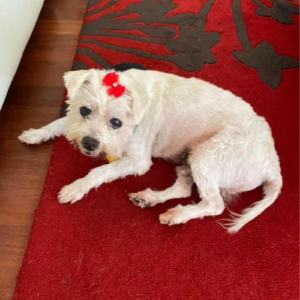 While in the Home’s care, Mr Darcy was given a Hill’s Science Diet consisting of wet food, which within a month had helped him gain much-needed weight, and recover from his anaemia.
While in the Home’s care, Mr Darcy was given a Hill’s Science Diet consisting of wet food, which within a month had helped him gain much-needed weight, and recover from his anaemia.
Thanks to the help of his foster carer, who assisted with regular eye drops, ear medication, antibiotics and pain relief, Mr Darcy looked like new man just weeks after his arrival. While he still has some chronic conditions that sadly can’t be completely resolved, with proper care, he’s now enjoying a great quality of pain-free life.
In foster care, Mr Darcy proved to be a very sweet dog with a love of food and human company, so combined with his friendly face and personality, he was a popular boy when he went up for adoption. But Mr Darcy also needed a very special home, with a very special family who could commit to monitoring and responding to his chronic health issues.
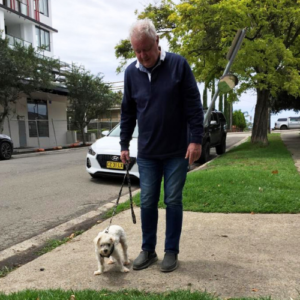 Luckily, it wasn’t long before the right family came along. Mr Darcy was adopted in December 2020 as a bright and comfortable senior, completely unrecognisable from the dirty Maltese who had arrived just six weeks prior.
Luckily, it wasn’t long before the right family came along. Mr Darcy was adopted in December 2020 as a bright and comfortable senior, completely unrecognisable from the dirty Maltese who had arrived just six weeks prior.
As Sydney’s only charity pound and community facility, we rely on donations to give senior pets a second chance in life. Donate today to the Senior Pet Project to give pets like Mr Darcy the care and treatment they need to thrive in their twilight years.
ABOUT THE SENIOR PET PROJECT
In its third year, our Senior Pet Project was started as an initiative not only to put a spotlight on golden oldies to help with their rehoming, but also to raise the funds required for their much needed veterinary care and often prolonged stay at the Home.
With your support we are looking to raise $50,000 to help fund the Senior Pet Project in the months ahead, enabling us to give the seniors entering our care a new leash on life.
Obi’s Story: From Agony to Adventure
When Obi (previously Yogi Bear) was brought into the Home in August 2020, it was clear he required immediate vet attention. The young Staffy cross’ collar was deeply imbedded into the flesh of his neck, suggesting his collar had been fitted when he was a young puppy and hadn’t been loosened as he grew.
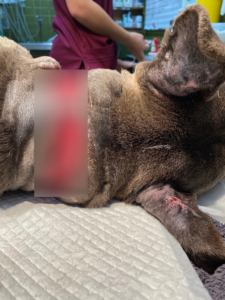 After an exam, our vet team determined Obi needed urgent surgery under anaesthesia to remove his collar. He immediately went into surgery, the collar was cut off and his wounds were cleaned, alleviating what could have been months of pain.
After an exam, our vet team determined Obi needed urgent surgery under anaesthesia to remove his collar. He immediately went into surgery, the collar was cut off and his wounds were cleaned, alleviating what could have been months of pain.
Over the next five weeks, Obi’s wounds were managed with regular cleaning and bandage changes under anaesthesia. Slowly, his wounds began to heal and contract, leaving him with the beautiful battle scars that today give Obi so much character.
As he settled into the Home, Obi began to show us his sweet, confident personality. While he proved very trainable, he also had a few behavioural traits including hyperactivity and mouthing, which often make it difficult for dogs to find a home.
But this wasn’t the case for Obi. After just two months in our care, Obi found a home with James. Building on Obi’s initial training at the Home, James has helped transform him into a well-mannered, much-loved dog who gets to go on lots of adventures.
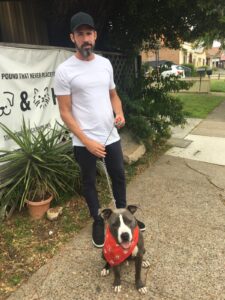 During the early stages of adoption, James was with Obi almost 24 hours a day, 7 days a week. We’re told Obi was house trained in two days, and within the first week, had mastered stop, sit, lie down, shake hands and to stop pulling on his leash. To this day, Obi practices his cues every night. James tells us, “it has not been easy, but worth every minute. We are both better off.”
During the early stages of adoption, James was with Obi almost 24 hours a day, 7 days a week. We’re told Obi was house trained in two days, and within the first week, had mastered stop, sit, lie down, shake hands and to stop pulling on his leash. To this day, Obi practices his cues every night. James tells us, “it has not been easy, but worth every minute. We are both better off.”
Since being adopted, Obi has overcome his separation anxiety and been exposed to lots of new people, dogs and places, including bush trails and the beach. He’s also now comfortable with other dogs, noises, people and traffic. As James puts it, “he is an amazing dog!”
As Sydney’s only charity pound, it’s only thanks to the generous support of our community that we can give dogs like Obi – who had such a rough past – the future they deserve. Thank you to all our wonderful donors, and thank you James, for giving Obi a wonderful new home.
If you’d like to help pets like Obi receive the care they desperately deserve, make a donation today.
Caring for A Deaf Cat
Have you ever encountered a deaf cat? It’s possible you may have met one without knowing it! Deaf cats can be just as alert and vibrant as their hearing counterparts, and our kitten Eddie is living proof. Eddie arrived in late November as an 8-week old stray, and following health checks, it became clear he was deaf. Eddie is now available for adoption with his hearing sibling and assistance cat Malcolm. They can’t wait to find a new home together, but first, their new family will need to learn a few things about caring for a deaf cat.
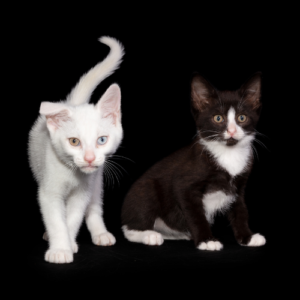 What causes deafness in cats?
What causes deafness in cats?
Like with humans, cat can lose their hearing as they age, or due to medication side effects or physical illness. However, in Eddie’s case, he has congenital deafness, meaning he has a genetic defect that caused him to be born deaf. Cats with a predominately white coat have the highest rate of congenital deafness.
What type of home is suitable for a deaf cat?
It’s important to provide a deaf cat with a protected indoor environment where they feel safe.
As SDCH Animal Care Manager & Vet Dr Renae Jackson notes, “the outside world is a very dangerous place for a deaf cat, as they can’t hear noises such as dogs, other cats and traffic.” To keep them safe, deaf cat must be kept indoors. They can have a great quality of life indoors, but if you would like to give them the opportunity to explore the outside world, an outdoor cat enclosure can be a great source of enrichment. Most cats can also be trained to use a harness and leash.
Deaf cats can be easily startled, so it’s important to provide safe places where they can survey their surroundings and minimise the risk of surprises. Dr Jackson notes, “high up places are the best, where no one can sneak up on them or accidentally step on them.” As such, it’s a good idea to provide lookout spots such as cat trees around the home.
It can be very scary for a deaf cat to have little hands touching them by surprise, so any children in the household must be mature enough to learn how to communicate effectively with the cat.
How do I communicate with a deaf cat?
Even without the ability to hear, deaf cats tend to be very alert and aware of their surroundings, using their other senses to take in information.
A few methods of communicating with a deaf cat include:
- Light cues – Light is a great way to get the attention of a deaf cat. Try flashing the overhead lights when entering the room, or using a laser pointer or penlight to catch their eye and redirect their attention.
- Hand signals – Sign language isn’t just for humans! Instead of aural cues, you can teach a deaf cat hand signals instead (see ‘How to train a deaf cat’).
- Vibrations – Cats can often feel low frequency vibrations, such as the vibrations you make when you flush a toilet or walk around the house. Try walking with a heavier stride or tapping the ground near a deaf cat to let them know you’re around. This works best on timber floors.
- Touch – Some deaf cats will still enjoy pets and cuddles, but they can startle easily without warning. Always come into their visual field before touching a deaf cat.
How to train a deaf cat
Training a deaf cat is all about communication, with a touch of patience, persistence and creativity.
A great place to start is by teaching hand signals for basic cues, such as ‘come’ or ‘meal time’. There are no set hand signals for training deaf cats, but many people use ASL, Auslan or make up their own basic signs.
Dr Renae Jackson recommends using positive reinforcement to pair a signal with a reward, so the cat knows what is being asked of them and that they will be rewarded for doing the right thing.
Begin by getting the cat’s attention through light, vibration, etc. Once they are looking at you, use your hand signal. If the cat displays the desired behaviour, reward them with a stroke along the torso, a tasty treat, or whatever reward they prefer. Over time, your cat will learn to associate the signal with the behaviour.
It’s important to teach your signals to everyone who lives in or visits your household, so they can communicate with your cat too.
Does a deaf cat need an assistance cat?
While deaf cats don’t necessarily need a hearing kitty companion to get by, it can be beneficial to have one in the home. These ‘assistance cats’ can communicate with deaf cats using visual indicators, helping them to learn routines. For example, Malcolm the assistance cat helps Eddie wake up when it’s time for dinner.
In multi-cat households, it’s important to set up plenty of opportunities for solo playtime with the deaf cat, so they don’t have to worry about being pounced on unexpectedly by their feline friends.
Adopting a deaf cat like Eddie and his helper cat Malcolm does require a little extra time and training, but once everyone in the household learns to communicate effectively, the experience can be very rewarding. In fact, we’ve had a volunteer who’s rescued one deaf cat from SDCH and come back for two more (see Paul’s Three White Deaf Cats)!
Interested in adopting Eddie and Malcolm? See their adoption profile to learn more and send an enquiry: https://sydneydogsandcatshome.org/adopt/
Published 18 Dec 2020
Transforming Lives 365 Days of the Year
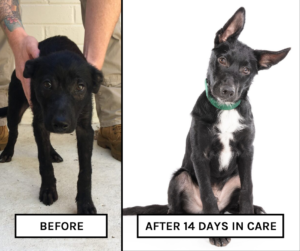 Miracles aren’t just for Christmas, with our team working tirelessly throughout the year to transform the lives of the stray and neglected pets who frequently arrive on the doorstep of Sydney Dogs & Cats Home.
Miracles aren’t just for Christmas, with our team working tirelessly throughout the year to transform the lives of the stray and neglected pets who frequently arrive on the doorstep of Sydney Dogs & Cats Home.
Munroe, a little Kelpie puppy, was picked up and brought in by the council ranger in mid-November 2020. A shy, timid boy, Munroe was extremely underweight and suffered from hair loss, likely the result of flea allergy dermatitis. The team estimated Munroe was about 10 weeks of age, and they immediately developed and implemented a treatment plan to help this weak little nugget turn into a thriving puppy.
Munroe was immediately treated with Advocate to kill any fleas and mites – the probable cause of his poor skin condition and hair loss. He was also put on a regime of twice-weekly colloidal oatmeal shampoos. Our vet Michelle also prescribed a special Hill’s Pet Nutrition diet to help with his weight and resolution of his skin issues.
The transformation was amazing. In as little as two weeks, Munroe’s skin condition resolved and we saw a healthy, shiny coat of fur emerging. He also began to grow, not only putting on much-needed weight but also shooting up several inches in size.
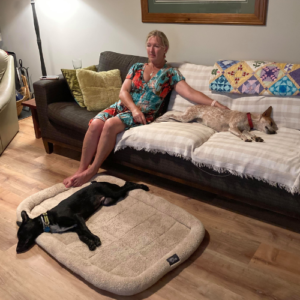 After just one month in our care, Munroe (now named Sunny) was adopted by Robert and his family, just in time for Christmas. Munroe now has a canine companion named Rosie, and we’re told they’re very happy together, especially when they’re exploring the bush. Robert said, “He is such a sweet boy, putting on weight, growing and [has] a really shiny coat.”
After just one month in our care, Munroe (now named Sunny) was adopted by Robert and his family, just in time for Christmas. Munroe now has a canine companion named Rosie, and we’re told they’re very happy together, especially when they’re exploring the bush. Robert said, “He is such a sweet boy, putting on weight, growing and [has] a really shiny coat.”
Sydney Dogs & Cats Home is only able to help transform the lives of abandoned and neglected pets like Munroe thanks to the generous support of our community and our partners.
Taking in nearly 3,000 pets each year, the Home needs the community’s support to continue its important, often life-saving work.
We invested well over $300 in Munroe’s treatment which included vet checks and vaccinations. Please donate now for pets like Munroe – every little bit helps.
Donate here: https://sydneydogsandcatshome.org/donate/
Paul’s Three White Deaf Cats
 Paul had always loved cats. All his life, he had a cat in the family. He found himself drawn to them, enthralled by their ability to make you earn their trust.
Paul had always loved cats. All his life, he had a cat in the family. He found himself drawn to them, enthralled by their ability to make you earn their trust.
Paul’s first cat was a rescue. When he was 13, his family took on a sick abandoned cat, who went on to become a much-loved member of the family for 24 years. To Paul, that cat was his best friend. So when he moved out of home, he needed a cat. His first came from a pet store after he saw the black beauty looking alone and unhappy in her enclosure. She went home with Paul, and a few months later, he was back for a second – the runt of the litter who hid in the back of the enclosure, trampled by her siblings.
16 years later, Paul had to say goodbye to his special runt. Having had surgery a week earlier, he was in a bad place and felt incomplete with only one cat. His black beauty was also on the sad side, missing her sibling.
A few months later in June 2019, Paul’s parents, who had been without a cat for a few years, were feeling it was time to get a new pet. Paul suggested looking at Sydney Dogs & Cats Home, as we’d recently helped reunite his daughter with her lost dog. His parents looked at our website and noticed Basil the cat, who they adopted that day.
Paul went with his mum to collect Basil. He always felt a need to take less-loved and under-appreciated animals under his wing, so seeing all the beautiful animals needing a home broke his heart. He asked if he could stay in the cattery and show the cats some love, where he noticed a gorgeous white cat watching his every move.
When Paul took his mother and her new cat home, he couldn’t keep the white cat out of his head, convinced he needed a second cat in his life. Paul’s mother asked what was wrong, and when he explained, his mother laughed. “Go get him,” she said.
Half an hour later, Paul was back at Sydney Dogs & Cats Home learning more about the curious white cat. The staff surprised him when they said he was deaf. But that didn’t matter. Paul took Hunter the cat home and he and his two children were blessed again with two cats. Hunter adjusted quickly to adopted life and soon became a valued member of the family.
 Some months later, Paul’s black beauty reached 18 years and her health declined, so the family had to say goodbye. Though Hunter had only known his adopted sibling for a few months, Paul noticed he felt the loss.
Some months later, Paul’s black beauty reached 18 years and her health declined, so the family had to say goodbye. Though Hunter had only known his adopted sibling for a few months, Paul noticed he felt the loss.
But with time, Hunter recovered and his true colours began to shine. He was cheeky, full or life and very affectionate, when he felt like it.
Shortly after he’d lost his black beauty, Paul received an unexpected phone call from Sydney Dogs & Cats Home. We had a gorgeous white female cat ready to be adopted into an indoor home. This cat was something special – just like Hunter, she was deaf.
Paul grabbed the kids and whisked into the shelter. Before they knew it, they had a second white deaf cat. Already having Hunter, the family decided on the name Holly, and so the joke became that Paul had Holly Hunter at home.
 Hunter was happy to have a friend again. Him and Holly were a great pair and very quickly made Paul’s life feel full again.
Hunter was happy to have a friend again. Him and Holly were a great pair and very quickly made Paul’s life feel full again.
Having rescued two amazing cats from Sydney Dogs & Cats Home, Paul volunteered his IT services to help the Home and our furry residents. In October 2019, the internet went out for a few days, so he took a backup service to keep us up and running.
The internet was fixed and for a while, Paul forgot to pick up his loan equipment. So we gave him a call with an incentive. “It will be worth your while,” we said.
So Paul came into the Home, expecting to be rewarded with some playtime in the cattery. Instead, he was shown a dazzling white deaf cat named Nimbus with striking blue eyes. So as tradition told, cat number three was welcomed into Paul’s family.
 Nimbus ruined the Holly Hunter joke, so the family made clever use of alliteration to rename the new addition. So Nimbus became Hettie, and she settled in well with her new siblings.
Nimbus ruined the Holly Hunter joke, so the family made clever use of alliteration to rename the new addition. So Nimbus became Hettie, and she settled in well with her new siblings.
While Paul notes that the cats’ inability to react to sound is challenging, they know hand gestures and body language, and each has their own quirky thing they respond to.
Paul said his experience with Holly, Hunter and Hettie has made his family appreciate the importance of adopting pets who need a loving home.
“Even my children who are 14 and 8 understand that #AdoptDontShop is the right thing to do as it means that an animal who has lost all hope is given a chance again at being a loved family member,” he said.
“I cannot recommend Sydney Dog & Cats home enough to everyone I know, and I encourage everyone to Adopt Not Shop with them.
If it wasn’t for them, I wouldn’t have my three fur babies who mean the world to me and have made not only our lives – but our home – complete.”
Want to see more of Hunter, Hollie and Hettie? Follow their Instagram @hunter_holly_and_hettie.
Archives
- February 2025
- January 2025
- August 2024
- July 2024
- June 2024
- April 2024
- February 2024
- January 2024
- October 2023
- September 2023
- August 2023
- June 2023
- March 2023
- February 2023
- January 2023
- December 2022
- November 2022
- October 2022
- September 2022
- June 2022
- May 2022
- March 2022
- February 2022
- December 2021
- November 2021
- October 2021
- September 2021
- July 2021
- April 2021
- March 2021
- February 2021
- January 2021
- December 2020
- November 2020
- October 2020
- September 2020
- August 2020
- June 2020
- May 2020
- April 2020
- January 2020
- November 2019
- October 2019
- September 2019
- August 2019
- July 2019
- June 2019
- May 2019
- March 2019
- January 2019
- November 2018
- October 2018
- September 2018
- August 2018
- July 2018
- June 2018
- May 2018
- April 2018
- February 2018
- January 2018
- December 2017
- November 2017
- October 2017
- September 2017
- August 2017
- May 2017




 MON-SUN:
MON-SUN:
 02 9587 9611
02 9587 9611 INFO@SYDNEYDOGSANDCATSHOME.ORG
INFO@SYDNEYDOGSANDCATSHOME.ORG







